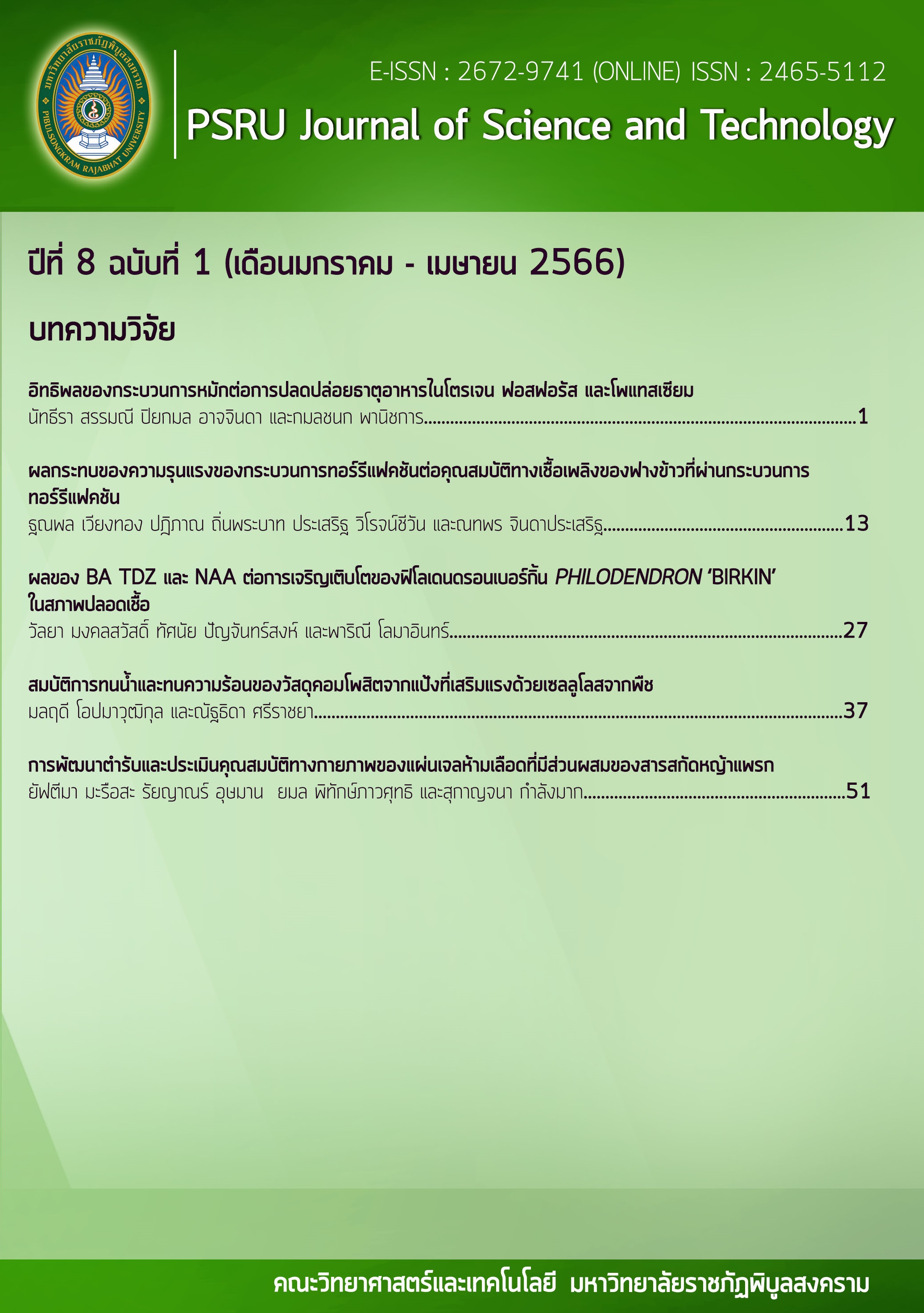WATER AND THERMAL-RESISTANT PROPERTIES OF STARCH-BASED COMPOSITES REINFORCED WITH PLANT CELLULOSE
Keywords:
Water-resistant, Thermal-resistant, Composites, Tala palm cellulose, Rami celluloseAbstract
Starch is a polymer material widely used in biomaterial area. Due to its limitations in strength and stability, this study investigated appropriate type and amount of cellulose for strengthening stability, water-resistant, and thermal-resistant properties of starch-based composites. Selected cellulose fibers in this study were tala palm ones for the short and rami ones for the long. Initially, chemical pretreatment (10% NaOH, 4% H2SO4 and 10% NaOCl) was carried out to remove the lignins and hemicelluloses. Then the proper proportions between starch (matrix) and cellulose (reinforcement) were determined. The mixtures were molded using heat-moisture drying technique at 40˚C. Water-resistant tests were carried out by immersing the samples in water at room temperature for 60 minutes. Meanwhile, thermal-resistant tests were executed at 100˚C for 60 minutes. The samples were finally assessed the stability. It was found that the proper proportion was the suspension of starch 1: water 3 and 1% wt. pretreated cellulose. When molded, all the samples remained shapes as molded, no cracking and no breaking. Apparently, the top surfaces of samples became rough according to the spreading of the fibers. It was obvious that tala palm fibers were generally embedded in the surrounding matrix, hence appeared better adhesion to the matrix phase than that of rami ones. At this unsimilar point, it caused different stable appearances under similar hydrated and heated conditions. Therefore, the composites reinforced with tala palm cellulose provided the better stability. This is useful for applying for water- and thermal-resistant green packaging.
References
กรมส่งเสริมอุตสาหกรรม. (2562). ไบโอพลาสติก. สืบค้นเมื่อ 2 ธันวาคม 2564, จาก http://innovation.dip.go.th/
innovation/?page_id=1094.
เขมจิราณัฐ ชัชวาลย์. (2560). การดัดแปรสตาร์ชมันสำปะหลังด้วยวิธีการคั่วในภาชนะแบบเปิด. (ปริญญานิพนธ์มหาบัณฑิต). มหาวิทยาลัยศิลปากร บัณฑิตวิทยาลัย สาขาวิชาเทคโนโลยีอาหาร.
ณัฐฐา กล้าณรงค์. (2562). การเตรียมแป้งมันสำปะหลังออกซิไดซ์ด้วยกระบวนการพลาสมาวัฏภาคของเหลวสำหรับใช้งานด้านฟิล์มห่อหุ้มอาหารที่สามารถย่อยสลายได้ทางชีวภาพ. (ปริญญานิพนธ์มหาบัณฑิต). มหาวิทยาลัยนเรศวร บัณฑิตวิทยาลัย สาขาวิชาวิศวกรรมเคมี.
ธนพล รัตนจรัสโรจน์, และวรนุช ศรีเจษฎารักข์. (2558). ผลของสภาวะการแปรรูปแป้งมันสำปะหลังต่อปริมาณแป้งทนการย่อย. ใน การประชุมวิชาการระดับชาติมหาวิทยาลัยรังสิต ประจำปี 2558 (น. 394-401) กรุงเทพ ฯ: มหาวิทยาลัยรังสิต.
บุญรักษ์ กาญจนวรวณิชย์. (2004). โพลิเมอร์คอมโพสิต. สืบค้นเมื่อ 6 พฤษภาคม 2564, จาก http://www.neutron.rmutphysics.com/news/index.php?option=com_content&task=view&id=1608&Itemid=9.
พิมภนิจภา กันทาดง, มินตรา พีเกาะ, และอรธีรา สินด่านจาก. (2562). ฟิล์มคอมโพสิตชีวภาพจากแป้งมันสำปะหลังเสริมแรงด้วยเส้นใยเซลลูโลสเปลือกทุเรียน. วารสารวิชาการและวิจัย มทร.พระนคร, 13(1), 39-50.
วิจิตรา เหลียวตระกูล, และวชิรญา เหลียวตระกูล. (2563). ผลของวิธีการดัดแปรแป้งด้วยกรดและพรีเจลาติไนเซชันต่อสมบัติทางเคมีกายภาพของแป้งกระจับ. วารสารเทคโนโลยีการอาหาร มหาวิทยาลัยสยาม, 15(2), 82-95.
ศศิกานต์ สุวรรณประทีป, อดุลย์ หาญวังม่วง, และสมพงษ์ พิริยายนต์. (2562). การผลิตโฟมบรรจุภัณฑ์จากแป้งข้าวเจ้าผสมด้วยเส้นใยเซลลูโลสจากผักตบชวา (รายงานวิจัยฉบับสมบูรณ์). นนทบุรี: มหาวิทยาลัยเทคโนโลยีราชมงคลสุวรรณภูมิ
Arifin, H.R., Djali, M., Nurhadi, B., Hasim, S.A., Hilmi, A., & Puspitasari, A.V. (2022) Improved properties of corn starch-based bio-nanocomposite film with different types of plasticizers reinforced by nanocrystalline cellulose, International Journal of Food Properties, 25(1), 509-521.
Faruk, O., & Ain, M.S. (2013). Biofiber reinforced polymer composites for structural applications. In Uddin, N. (Ed). Developments in fiber-reinforced polymer (FRP) composites for civil engineering (pp. 18-53). Woodhead Publishing.
Lamaming, J., Hashim, R., Sulaiman, O., Leh, C.P., Sugimoto, T., & Nordin, N.A. (2015). Cellulose nanocrystals isolated from oil palm trunk. Carbohydrate Polymers, 127, 202-208.
Srirachya, N., Boonkerd, K., Nakajima, L., & Kobayashi, T. (2018). Bio-composite hydrogels of cellulose and vulcanized natural rubber with nanointerconnected layers for reinforced water-retaining materials. Polymer Bulletin, 75(12), 5493-5512.
Srirachya, N., & Nido, A. (2020). The Green Preparation of Cellulose Fibrils from Oil Palm Leaf Stalk Fibers for Hydrogel Applications. Key Engineering Materials, 841, 103-107.
T441 om-13. (2013). Water absorptiveness of sized (non-bibulous) paper, paperboard, and corrugated fiberboard (Cobb test). Retrieved November, 7, 2021, from https://www.tappi.org/content/tag/sarg/t441.pdf.
T453 sp-13. (2013). Effect of dry heat on properties of paper and board. Retrieved November, 7, 2021, from https://www.tappi.org/content/tag/sarg/t453.pdf.
Zoghlami, A., & Paës, G. (2019). Lignocellulosic biomass: understanding recalcitrance and predicting hydrolysis. Frontiers in Chemistry, 7, https://doi.org/10.3389/fchem.2019.00874.
Downloads
Published
Versions
- 2024-05-29 (2)
- 2023-04-21 (1)
How to Cite
Issue
Section
License
Copyright (c) 2023 PSRU Journal of Science and Technology

This work is licensed under a Creative Commons Attribution-NonCommercial-NoDerivatives 4.0 International License.
กองบรรณาธิการขอสงวนสิทธิ์ในการปรับปรุงแก้ไขตัวอักษรและคำสะกดต่างๆ ที่ไม่ถูกต้อง และต้นฉบับที่ได้รับการตีพิมพ์ในวารสาร PSRU Journal of Science and Technology ถือเป็นกรรมสิทธิ์ของคณะวิทยาศาสตร์และเทคโนโลยี มหาวิทยาลัยราชภัฏพิบูลสงคราม และ
ผลการพิจารณาคัดเลือกบทความตีพิมพ์ในวารสารให้ถือมติของกองบรรณาธิการเป็นที่สิ้นสุด







